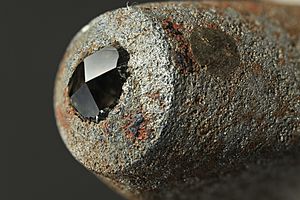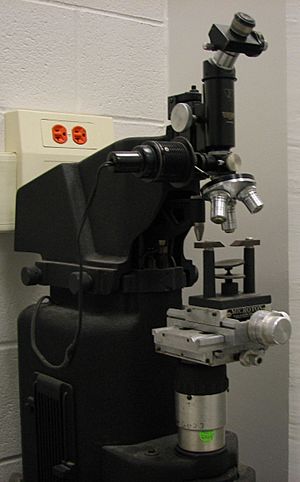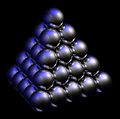Hardness facts for kids
Hardness tells us how much a material can resist being scratched, dented, or bent. Think of it as how tough something is. Very hard materials don't easily change their shape when you push on them.
Some examples of really hard materials are diamonds, special metal compounds called carbides, and quartz. Even everyday things like strong steel, ice, granite, and concrete are considered hard.
Materials that are harder are tougher to cut or shape. They often don't bend much. Instead, they might shatter if you try to bend them too far. Hard materials are super important in many jobs. For example, tools for cutting, parts for machines, and building materials are usually made from hard stuff.
One way to check how hard a mineral is, is by using the Mohs scale of mineral hardness. This scale uses a scratch test. For metals and man-made materials, other tests like compression or rebound tests are often used.
Contents
How We Measure Hardness
There are three main ways to measure how hard something is: by scratching it, by pressing into it, or by seeing how much something bounces off it. Each method has its own special tests and scales. Sometimes, people use special charts to change measurements from one scale to another.
Measuring Scratch Hardness
Scratch hardness shows how well a material can stop itself from being scratched or permanently marked by a sharp object. The idea is simple: a harder material will scratch a softer one. When testing coatings, scratch hardness means how much force is needed to scratch through the coating down to the material underneath.
The most famous scratch test is the Mohs scale. Scientists who study minerals use it a lot. A tool called a sclerometer can help with this measurement.
Another simple tool for scratch tests is a pocket hardness tester. It has a special arm with marks on it, attached to a small cart with wheels. A sharp scratching tool is set at a certain angle. To use it, you add a known weight to the arm. Then, you pull the tool across the material you want to test. This way, you can apply a known pressure without needing big, complex machines.
Measuring Indentation Hardness
Indentation hardness measures how much a material resists being dented. This happens when a steady pushing force from a sharp object is applied. These tests are mostly used in engineering and when working with metals. The main idea is to measure the size of the dent left behind by a special tool called an indenter.
Some common tests for indentation hardness include the Rockwell, Vickers, Shore, and Brinell tests.
Measuring Rebound Hardness
Rebound hardness, also called dynamic hardness, measures how high a special hammer bounces. This hammer has a diamond tip and is dropped from a set height onto the material. This type of hardness is linked to how bouncy or springy a material is. The machine used for this measurement is called a scleroscope.
Two scales that measure rebound hardness are the Leeb rebound hardness test and the Bennett hardness scale.
Images for kids
See also
 In Spanish: Dureza para niños
In Spanish: Dureza para niños




